Basal Cell Carcinoma
The appearance of basal cell carcinoma can be diverse and subtle, showing as red patches of skin, pink growths, open sores, or shiny bumps. Notably, its understated presentation makes early detection challenging.
The primary cause of BCC is prolonged exposure to harmful levels of ultraviolet (UV) rays. Sunlight, a common source of UV rays, can damage cellular DNA—a critical component in the creation of new cells. While the body typically possesses an internal surveillance and repair mechanism for damaged DNA, basal cell carcinoma may develop when the extent of sun damage surpasses the repair mechanism's effectiveness.
SeaCoast Skin Surgery expert providers specialize in the comprehensive diagnosis and treatment of all skin cancers, including basal cell carcinoma. Annual Total Body Skin Exams are very important, as the dermatologists at SeaCoast Skin Surgery are trained to detect unusual spots early leading to finding smaller basal cell carcinomas during routine examinations. Take the proactive step towards healthy skin by scheduling an appointment with one of our trusted dermatologists today. As global leaders and innovators in skin cancer surgery and reconstruction, SeaCoast Skin Surgery is committed to your skin health journey.
Examples of Basal Cell Carcinoma
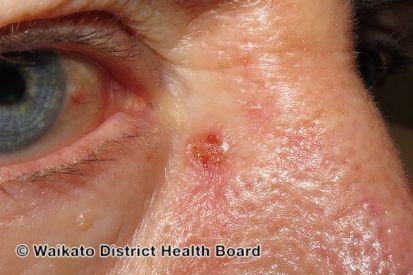
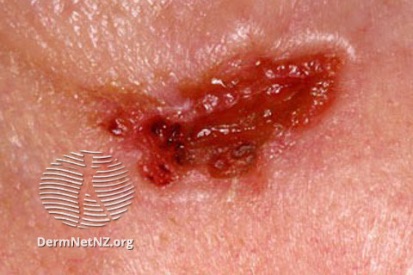
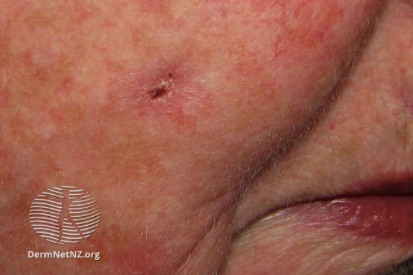
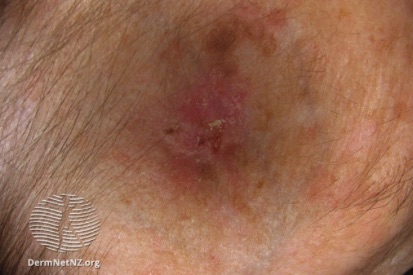
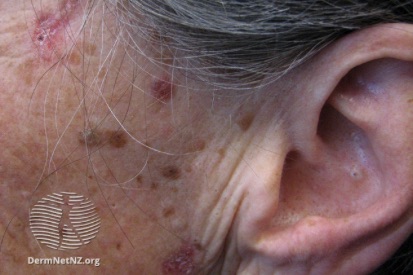
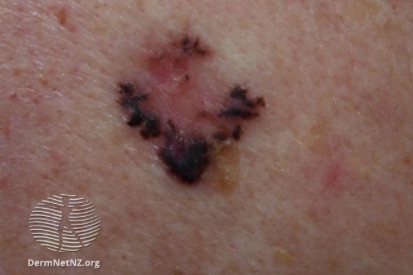
Symptoms of Basal Cell Carcinoma
Basal cell carcinoma (BCC) is the most common form of skin cancer and often develops in areas of the body that are frequently exposed to the sun. Basal cell carcinoma on the face is particularly common. Other frequent sites include the neck, scalp, and arms. Early-stage basal cell carcinoma can be subtle and may resemble non-threatening skin conditions.
BCC typically presents as slow-growing lesions that rarely cause pain but may become problematic over time if untreated. These lesions may look like shiny, pearly bumps, open sores that don’t heal, or flat, scar-like areas. It's essential to consult a dermatologist if you notice any persistent or changing spots on your skin.
Common signs and symptoms of BCC include:
- A pearly or waxy bump, often with visible blood vessels
- A flat, flesh-colored, or brown scar-like lesion
- An open sore that bleeds, oozes, or crusts and remains open for weeks
- A pink growth with a slightly raised, rolled border and a crusted indentation in the center
- A red patch that may itch or hurt
- Lesions developing on sun-exposed areas like the face, ears, neck, scalp, shoulders, and back
Causes of Basal Cell Carcinoma
The primary cause of BCC is prolonged exposure to ultraviolet (UV) radiation from the sun or tanning beds. Those over the age of 40 are also more susceptible to BCC. While anyone can develop it, certain risk factors increase the likelihood, including genetics and skin type.
Common causes of BCC include:
- Chronic sun exposure, especially as a child, without protection
- Use of tanning beds
- Fair skin, light eyes, and blond or red hair
- A history of severe sunburns, especially in childhood
- A family history of skin cancer
- Genetic conditions, such as basal cell nevus syndrome
- A weakened immune system due to illness or medication
Preventing Basal Cell Carcinoma
While basal cell cancer is most often caused by cumulative sun exposure, many cases can be prevented or caught early with the right habits. Practicing sun protection year-round and regular skin checks can help reduce risk. Understanding what BCC looks like, especially in the early stages, is critical for catching it before it becomes severe.
Common preventative measures include:
- Using a broad-spectrum sunscreen with SPF 30 or higher daily, even on cloudy days
- Avoiding sun exposure during peak hours (10 AM – 4 PM)
- Wearing protective clothing, wide-brimmed hats, and UV-blocking sunglasses when outdoors
- Staying in the shade whenever possible, especially during midday
- Avoiding tanning beds, which significantly increase skin cancer risk
- Performing regular self-skin checks and being aware of BCC symptoms, such as shiny bumps, open sores, or scar-like patches
- Learning to recognize what basal cell carcinoma looks like using credible resources and basal cell carcinoma pictures of the early stages
- Scheduling annual total body skin examinations with a dermatologist for professional screening
Basal Cell Carcinoma FAQs
You can prevent Basal Cell Carcinoma (BCC) by consistently using a broad-spectrum sunscreen with a high SPF, wearing sun-protective clothing, avoiding tanning beds, and seeking shade during peak sun hours. Performing self-examinations and seeing a dermatologist regularly for a Total Body Skin exam are key to preventing BCC.
Treatment options for Basal Cell Carcinoma include surgical procedures (such as surgical excision or Mohs surgery), non-surgical approaches like topical medications or photodynamic therapy, and occasionally radiation therapy, depending on factors like the tumor size, location, and the patient's medical history. Your dermatologist will review your options with you and recommend a treatment plan.
Yes, Basal Cell Carcinoma can recur, emphasizing the importance of regular Total Body Skin Exams performed by your dermatologist, self-examinations and use of sun safety measures including sunscreen and sun-protective clothing.
Yes, Mohs micrographic surgery proves to be an effective treatment for Basal Cell Carcinoma (BCC), particularly in sensitive areas like the face, ears, and nose. This specialized technique involves the meticulous removal of cancerous tissue in layers, examined under a microscope immediately, ensuring thorough removal of cancer cells while minimizing impact on healthy surrounding tissue. Mohs surgery is often recommended for large, poorly defined, or high-risk BCCs, providing high cure rates and favorable cosmetic outcomes in delicate regions. However, the choice of treatment depends on various factors and should be discussed with a dermatologist or skin cancer specialist.
Basal Cell Carcinoma is diagnosed through a skin biopsy, where a small sample of the suspicious skin tissue is taken and examined under a microscope to confirm the presence of cancer cells, with additional imaging tests occasionally used to determine the extent of the cancer. Early detection and consultation with a dermatologist or skin cancer specialists are key in initiating the diagnostic process.
Basal Cell Carcinoma is primarily caused by prolonged exposure to UV rays, particularly from sunlight, damaging skin cell DNA and increasing the risk of cancer. Effective sun protection is vital in minimizing this risk.
From Our QualDerm Family of Providers: Why Early Detection For Skin Cancer Is Critical
How to Treat Basal Cell Carcinoma
Treatment for BCC depends on several factors, including the size, depth, and location of the lesion, as well as the patient’s overall health. With various effective approaches available, from surgical options to newer non-invasive therapies, it’s crucial to tailor the treatment to each case. Early intervention can improve outcomes and minimize scarring. Whether the goal is basal skin carcinoma removal or long-term management, knowing the range of available treatments is essential.
Non-Surgical Treatments
There are several non-surgical treatment options for patients who are not candidates for surgery or prefer less invasive approaches. These include topical medications such as imiquimod or 5-fluorouracil, which can be effective for superficial BCCs.
Basal cell carcinoma radiation treatment may be recommended for older adults or those with tumors in difficult-to-operate locations. Electrodesiccation and curettage involve numbing the area, scraping off the lesion, and cauterizing it to destroy remaining tumor cells and control bleeding. Cryotherapy is another option, which freezes the lesion with liquid nitrogen. Additionally, superficial radiation therapy (SRT) treatment for skin cancer is emerging as a non-invasive alternative for certain patients, particularly for low-risk lesions.
Surgical Procedures
Surgery remains the most common and effective option for basal cell carcinoma treatment. Excisional surgery involves cutting out the cancerous lesion along with a small margin of healthy tissue to ensure complete removal. Another highly effective technique is Mohs surgery for basal cell carcinoma, especially used for facial areas or lesions with a high risk of recurrence.
This precise method involves removing the cancer layer by layer while examining each layer under a microscope, ensuring minimal damage to surrounding healthy skin. Mohs surgery offers the highest cure rates, around 98% for primary, non-recurrent BCC, while preserving healthy tissue and delivering excellent cosmetic outcomes.
New and Emerging Treatments
Advancements in skin cancer treatment have led to promising new therapies for basal cell carcinoma. Targeted drugs such as hedgehog pathway inhibitors are used for advanced or recurrent cases that don’t respond well to conventional treatment. Immunotherapy and photodynamic therapy are also being explored in clinical settings for patients who need alternatives to traditional basal cell carcinoma surgery.
Topical therapeutic options, including certain creams or ointments, may also be considered for specific lesions. Your dermatologist will discuss these based on the characteristics of your basal cell carcinoma.
Featured Products for Sun Protection
Check your local office for current stock!
Check your local office for current stock!
